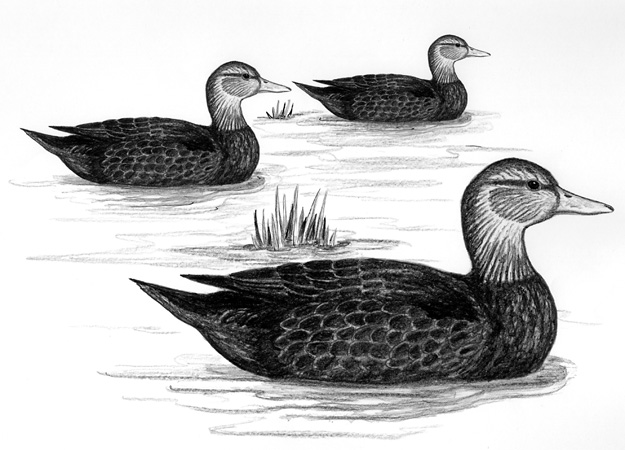
Dear Bird Folks,
My father used to tell me about a breed of ducks called “Canadian Red-legs.” He said they are a lot like American Black Ducks, only much larger, and with red legs. He and his buddies used to see them in January when they were out duck hunting. Do you know anything about Canadian Red-legs? I couldn’t find any info about them in my bird books.
– Ron, Sandwich, MA
Really, Ron?
I’ve just recovered from the Thanksgiving turkey carnage and now you hit me with a question that has to do with duck hunting. Can’t we give the poor birds a break? Why is everybody always trying to eat them? Remember a few years ago when the entire country freaked out and sent that bonehead Michael Vick to jail for allowing large, aggressive dogs to fight each other? Yet, when someone turns a shotgun loose on a 36-ounce duck, everybody is okay with it. Where’s the justice? I especially feel bad for any bird that is saddled with the name of Canadian Red-legs. Talk about embarrassing. I know exactly how they must feel. Back in the days when I’d spend the summer on the beach, I was known as “Cape Cod White-legs.” But that’s another story for another time.
I know the reason why you haven’t been able to find any info on Canadian Red-legs. It’s because there is no such bird. There really isn’t. The birds your father was talking about were most likely just regular American Black Ducks. Some black ducks do have brighter legs than others, but it is thought that leg color has to do with age and sex and is not a different species, or even a subspecies. The black ducks that breed here on Cape Cod, or on Long Island or in far northern Canada, are exactly the same in every respect, except the Canadian birds are a lot politer.
Even though everyone reading this column has seen black ducks before, they probably didn’t know it, or even cared. Wood Ducks, mergansers, eiders and most other ducks readily attract our attention, but not black ducks. They are like the words on a rental car agreement; no one pays attention to them. In fact, these ducks aren’t even black, that would be too flashy for them. Their plumage is more of a lackluster, grayish brown. They are often described as looking like mallards dressed for a funeral. Also, with most ducks there is a clear distinction between the hens and the drakes, but this is not the case with black ducks. The males and the females look nearly identical. This has led to the rumor that black ducks are into cross-dressing, but so far they aren’t admitting to it.
Black duck belong to a group of birds known as puddle or dabbling ducks. These ducks spend much of their time in shallow water where they feed by tipping their heads down and their back ends up, revealing their DA. They also have the ability to dive underwater, but usually only do so to escape danger or when looking for loose change. Because of their need for shallow water dabbling ducks have to leave northern areas in the winter. Most head south or to the coast. Of this group, black ducks are the hardiest. If open water is available, they will remain as far north as the Great Lakes and the Saint Lawrence River. Many people in coastal communities associate black ducks with bays and salt marshes, but these ducks are equally at home in the deep woods. They love to breed in isolated bogs and ponds, especially those created by beavers.
Unfortunately, black ducks aren’t as common as they once were. One of the downsides of being bland and inconspicuous is that it took a long time before anyone noticed that the black duck population had taken a dramatic drop. The usual villains, habitat destruction and over development, were the major players in the decline of this duck. In addition, black ducks were constantly being over-hunted (which explains why they were always dressed for a funeral). Hunters were so obsessed with shooting these ducks that they didn’t want to stop even as the birds’ population plummeted. A 1982 lawsuit, filed by the Humane Society against U.S. Fish and Wildlife, led to better hunting restrictions, which has stabilized the ducks’ population. There is another rather odd factor in the decline of the black ducks and it has to do with Mallards. Mallards and black ducks are very closely related. Also, Mallard drakes, which must eat oysters when no one is looking, are extremely aggressive breeders. Interbreeding between the blacks and mallards has led to many odd-looking, and usually sterile, offspring. These sterile hybrids do very little to increase the population of either species. But, on a more positive note, hybrid ducks are known to get excellent gas mileage. So there’s that, at least.
You’ll be happy to know your dad was not alone in his belief that the American Black Duck has a larger cousin known as the Canadian Red-leg. Several older books suggest that such a species exists. However, more recent studies, including DNA testing, can find no evidence to support this claim. Black ducks are exactly the same throughout their entire range.
Sorry you’ll never get to see any Canadian Red-legs, Ron, but just be thankful you never witnessed the creature known as Cape Cod White-legs. That could have scarred you for life.